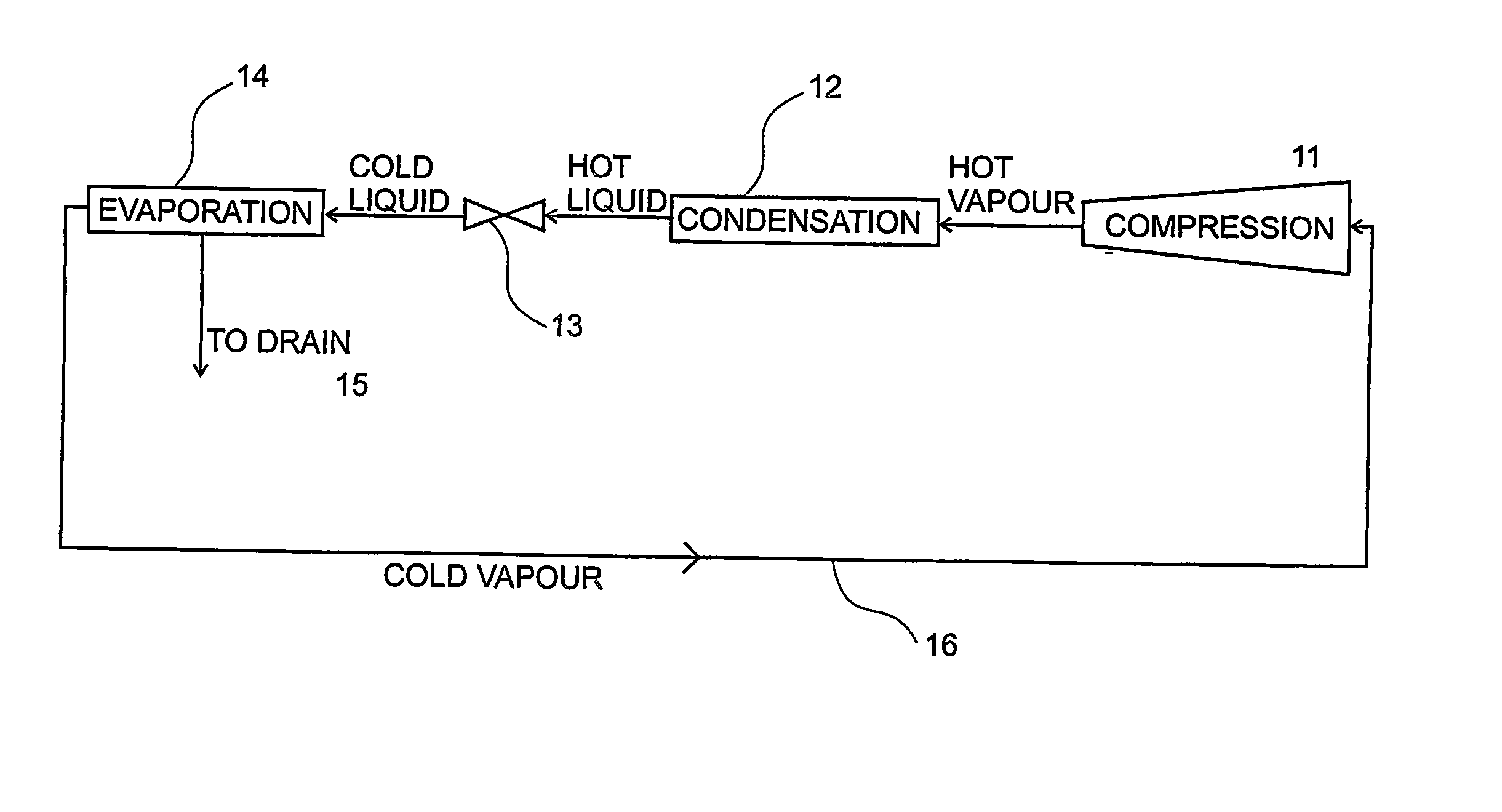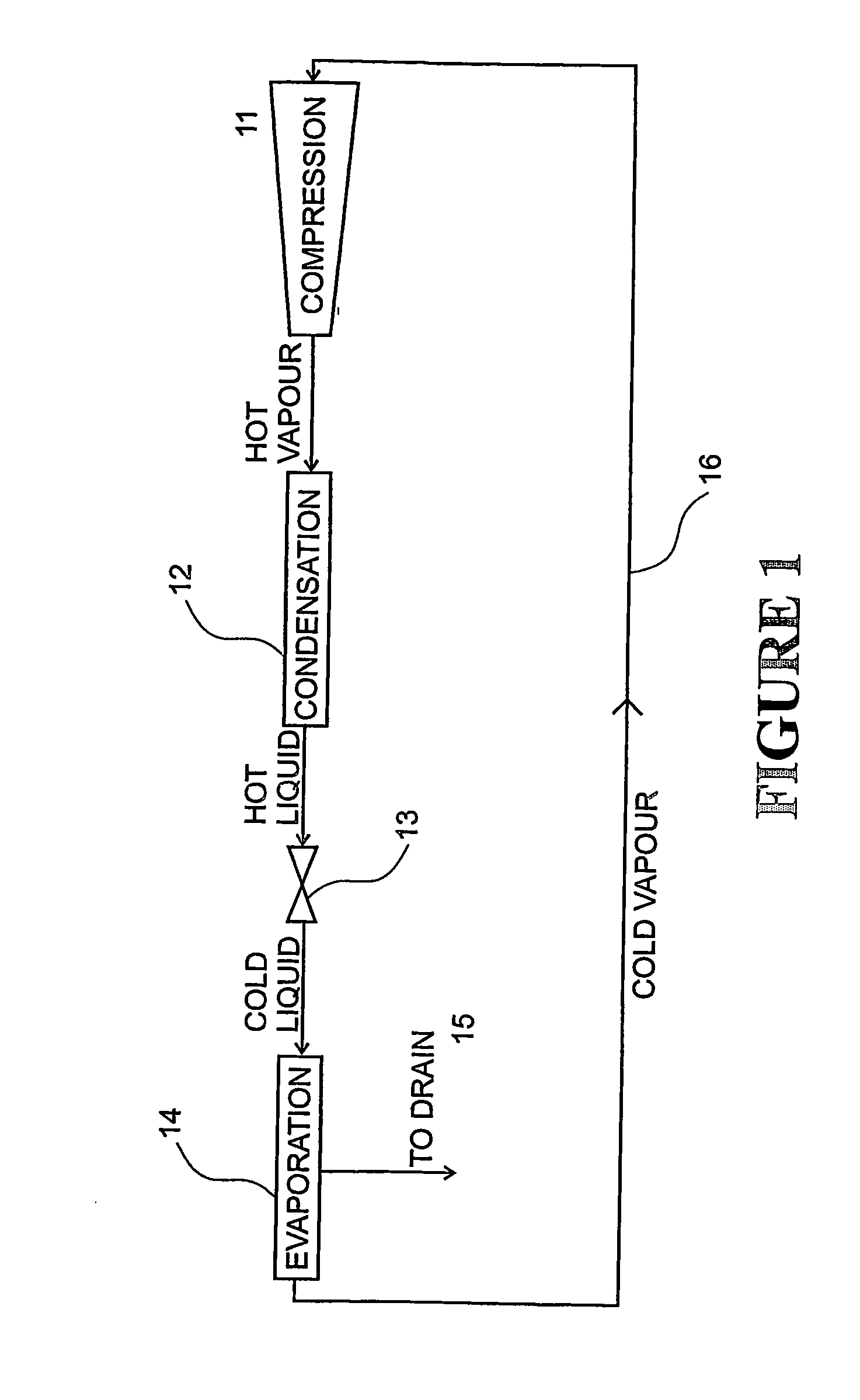This process is often relatively rapid but energy inefficient.
Alternative drying methods using
heat pump based drying systems have been generally known in industrial applications including timber drying for a number of years but they have had varying degrees of success based on limitations in performance, control and efficiency.
This need is complicated by the fact that the control of a heat pump dehumidifier system and the drying process parameters themselves are linked by multiple feed-back processes that are fundamentally different from the more commonly practiced but less efficient heat-and-vent drying systems.
One further problem that has developed more recently as part of the high drying speed is that the characteristics of the dried material are less suitable to the end users of the dried product.
In the case of timber, these difficulties include
kiln brown
stain and internal checking.
Another problem is the uneven drying that results when the hot drying gas, typically air, is passed over the material to be dried in a single direction throughout the process.
Material that is exposed to the hot drying gas first dries more quickly than the material further downstream in the configuration and can become over-dry on one side and under-dry on the other, with adverse quality implications.
However this problem of uneven drying is still present in heat pump driven kilns because the heat
pump design has so far prevented any efficient reversing of the drying gas flow during operation.
Another problem that is present with heat-and-vent kilns is their fundamentally poor energy efficiency.
Although they can sometimes be driven with
waste heat systems, low temperature heat-and-vent systems typically require a high
capital investment relative to their productivity which diminishes their attractiveness.
However, the controls and louvers in such a system will need to be positioned in the active drying gas flow path which tends to increase the pressure drop through the drying gas circuit which cuts into the efficiency gains for the process.
Another unsatisfactory aspect is that having critical mechanical
moving parts in the
kiln reduces system reliability.
Louver type
airflow controls tend to fail in the aggressive environment and this can result in damage to the product or the heat pump.
Although effective from an efficiency perspective, the
capital cost and operating difficulties associated with such a system are a significant
disadvantage.
Just as with the effort to reduce the
capital cost of a drying apparatus, the effort to improve its efficiency is never completely finished.
While effective in the
air conditioning application, this functionally series configuration is not flexible enough to work effectively in heat pump drying applications.
Cooperman's work clearly improves the performance of a heat pump system with an
ambient air heat source where a constant quantity of heat is required at the condenser but this is not suitable for a heat pump drying system which has widely varying requirements on the heat pump condenser side as well.
As for Cooperman's work, maintaining a strictly constant supply of heat is not well suited for drying applications.
Also, there is no capacity to vary the
heat output through the condenser or the flow of
refrigerant through it.
Again, there is no capacity to vary the
heat output through the condenser or the flow of refrigerant through it.
The difficulty with these last three attempts to improve heat pump performance through
evaporator area control is that they are specifically designed for use in open environments and to provide a constant supply of heat through the condenser.
The second is that the
heat flow required from the condenser drops off significantly as the material dries.
This makes such open heat source, constant
heat supply rate designs present in the prior art ill suited for drying applications.
Another problem with many existing heat and vent
kiln systems is the highly prominent vapour plume associated with the warm wet drying gas vented from the unit.
Although heat pump based systems with essentially
closed loop drying gas configurations essentially solve the plume problem, they do not possess other desirable characteristics of the heat and vent systems.
One of these specific characteristic problems with heat pump driven systems is the difficulty in reversing the drying gas flow in the drying chamber to promote even drying of the material as is done for heat-and-vent driers.
This problem results from the specific configuration of the heat pump condenser, which condenses the heat pump
working fluid and heats the recirculating drying gas
stream, and the heat pump
evaporator, which evaporates the heat pump
working fluid and removes some of the
moisture from the recirculating drying gas stream by cooling it and inducing water condensation.
Drying gas flow cannot be reversed in this system without dramatically reducing the drying capacity and efficiency, since it would result in the
evaporator wastefully recooling part of the heated drying gas from the condenser and removing less
moisture relative to the amount of heat removed.
Because drying gas flow reversal in the existing dehumidifiers is not practical, some dehumidifier timber kiln operators have attempted to overcome the problem of uneven drying by leaving the kiln fans running for long periods without running the dehumidifier, in order to even-up the
moisture content of the boards in different parts of the stack.
But this reduces the kiln
production rate and efficiency and thus reduces its profitability.
Without any details of the method of the heat pump dehumidification of the air or any claims relating to an apparatus to conduct their method, the problem remains.
The reversible air circulation system in U.S. Pat. No. 5,276,980 by Carter and Sprague is nominally applicable to heat pump systems but still has problems with its application.
One difficulty with this system is the
capital cost of the complex
air drying gas ducting system required for air off-take and return, and the cost of operating the fans needed to deliver the required air volumes.
The system has no capability of reversible drying gas flow nor does it provide for any recirculation or regeneration of the drying gas stream in a closed or semi-
closed loop configuration.
As such, these other attempts to control heat-and-vent processes do not address the problem for high efficiency heat pump driven systems with nominally closed loop drying gas recycle streams.
Again, this method does not address the operational limits and opportunities associated with a heat pump driven system.
Although they follow a schedule with a nominally constant
wet bulb temperature in the drying gas during the main part of the drying process, they decrease the
wet bulb temperature at the end of the process which would cause difficulties with a heat pump dehumidification process.
Since there is no heat pump dehumidification addressed in this work, it is also not able to address the efficiency issues associated with the simultaneous control of a heat pump dehumidifying system.
With the lower temperature differences present in heat pump dehumidification systems, this is not a practical measured variable for control and thus the problem remains.
This method has the
disadvantage that, as the product dries and the
wet bulb temperature falls in response, the dehumidifier drying capacity also falls, typically reducing the drying rate and the drying efficiency unnecessarily.
If the temperature is increased too early, the product may be damaged and lose value.
If the adjustment takes place too late, the
drying time will be unnecessarily extended, with accompanying loss of productivity and increased drying costs.
The control strategy suffers from similar limitations to those of Lewis in U.S. Pat. No. 4,250,629 and as a result does not fully address the problem of integrated control of the drying process and the heat pump system.
 Login to View More
Login to View More  Login to View More
Login to View More 


